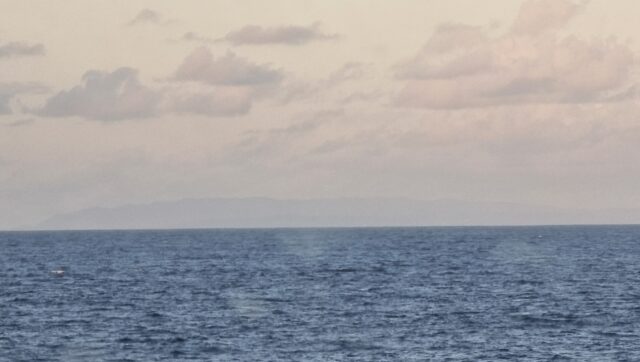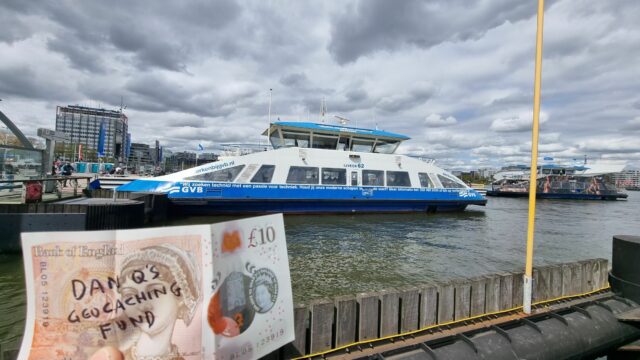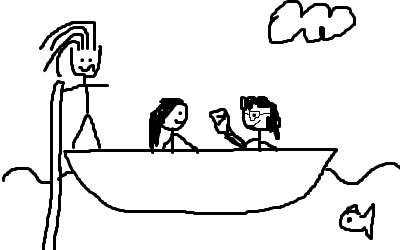Out for a dog walk this morning along the Nevern Estuary, I spotted this brave fellow rowing his way (at least) half naked across the bay, on a route that pitted him against the wind, rain, and tide!
Tag: boats
Small-World Serendipity
As part of our trip to the two-island republic of Trinidad & Tobago, Ruth and I decided we’d love to take a trip out to Buccoo Reef, off the coast of the smaller island. The place we’ve been staying during the Tobago leg of our visit made a couple of phone calls for us and suggested that we head on down to the boardwalk at nearby Buccoo the next morning where we’d apparently be able to meet somebody from Pops Tours who’d be able to take us out1.

At the allotted time, we found somebody from Pops Tours, who said that he was still waiting for their captain to get there3 and asked us to go sit under the almond tree down the other end of the boardwalk and he’d meet us there.

We’d previously clocked that one of the many small boats moored in the bay was Cariad, and found ourselves intensely curious. All of the other boats we’d seen had English-language names of the kinds you’d expect: a well-equipped pleasure craft optimistically named Fish Finder, a small dual-motorcraft with the moniker Bounty, a brightly-coloured party boat named Cool Runnings, and so on. To travel a third of the way around the world to find a boat named in a familiar Welsh word felt strange.
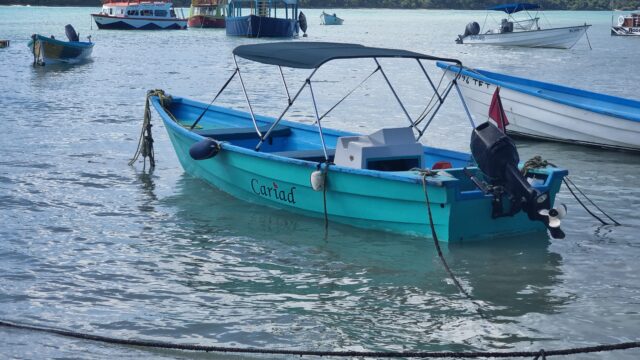
So imagine our delight when the fella we’d been chatting to came over, explained that their regular tour boat (presumably the one pictured on their website) was in the shop, and said that his cousin would be taking us out in his boat instead… and that cousin came over piloting… the Cariad!
As we climbed aboard, we spotted that he was wearing a t-shirt with a Welsh dragon on it, and a sticker on the side of the helm carried a Welsh flag. What strange coincidence is this, that Ruth and I – who met while living in Wales and come for a romantic getaway to the Caribbean – should happen to find ourselves aboard a literal “love” boat named in Welsh.

There probably aren’t many boats on Earth that fly both the colours of Trinidad & Tobago and of Wales, so we naturally had to ask: did you name this boat?, and why? It turns out that yes, our guide for the day has a love of and fascination with Wales that we never quite got to the bottom of. He’d taken a holiday to Swansea just last year, and would be returning to Wales again later this year.
It’s strange to think that anybody might deliberately take a holiday from a tropical island paradise to come to drizzly cold Wales, but there you have it. It sounds like he was into his football and that might have had an impact on his choice of destination, but choose to believe that maybe there’s a certain affinity between parts of the world that have experienced historical oppression at the hands of a colonial English mindset? Like: perhaps Nigerians would enjoy India as a getaway destination, or Guyanans would dig Mauritius as a holiday spot, too?5

We took a dip at the Nylon Pool, snorkelled around parts of Buccoo Reef (replete with tropical fish of infinite variety and colour), spotted sea turtles zipping around the boat, and took a walk along No Man’s Land (a curious peninsula, long and thin and cut-off from the mainland by mangrove swamps, so-named because Trinidadian law prohibits claiming ownership of any land within a certain distance of the high tide mark… and this particular beach spot consists entirely of such land, coast-to-coast, on account of its extreme narrowness. All in all, it was a delightful boating adventure.
(And for the benefit of the prospective tourist who stumbles upon this blog post in years to come, having somehow hit the right combination of keywords: we paid $400 TTD6 for the pair of us: that’s about £48 GBP at today’s exchange rate, which felt like exceptional value for an amazing experience given that we got the expedition entirely to ourselves.)

But aside from the fantastic voyage we got to go on, this expedition was noteworthy in particular for Cariad and her cymruphile captain. It feels like a special kind of small-world serendipity to discover such immediate and significant common ground with a stranger on the other side of an ocean… to coincide upon a shared interest in a culture and place less-foreign to you than to your host.
An enormous diolch yn fawr7 is due to Pops Tours for this remarkable experience.
Footnotes
1 Can I take a moment to observe how much easier it was to charter a boat in Tobago than it was in Ireland, where I left several answerphone messages but never even got a response? Although in the Irish boat owners’ defence, I was being creepy and mysterious by asking them to take me to random coordinates off the coast.
2 It’s possible that I’ve become slightly obsessed with frigatebirds since arriving here. I first spotted them from our ferry ride from Trinidad to Tobago, noticing their unusually widely-forked tails, striking white (in the case of the females) chests, and relatively-effortless (for a seabird) thermal-chasing flight. But they’re really cool! They’re a seabird… that isn’t waterproof and can’t swim… if they land in the water, they’re at serious risk of drowning! (Their lack of water-resistant feathers helps with their agility, most-likely.) Anyway – while they can snatch shallow-swimming prey out of the water, they seem to prefer to (and get at least 40% of their food from) stealing it from other birds, harassing them in-flight and snatching it from their bills, or else attacking them until they throw up and grabbing their victim’s vomit as it falls. Nature is weird and amazing.
3 Time works differently here. If you schedule something, it’s more a guideline than it is a timetable. When Ruth and I would try paddleboarding a few days later we turned up at the rental shack at their published opening time and hung out on the beach for most of an hour before messaging the owners via the number on their sign. After 15 minutes we got a response that said they’d be there in 10 minutes. They got there 20 minutes later and opened their shop. I’m not complaining – the beach was lovely and just lounging around in the warm sea air with a cold drink from a nearby bar was great – but I learned from the experience that if you’re planning to meet somebody at a particular time here, you might consider bringing a book. (Last-minute postscript: while trying to arrange our next accommodation, alongside writing this post, I was told that I’d receive a phone call “in half an hour” to arrange payment: that was over an hour ago…)
4 Come for the story of small-world serendipity; stay for the copious candid bird photos, I guess?
5 I’ll tell you one thing about coming out to Trinidad & Tobago, it makes you feel occasionally (and justifiably) awkward for the colonial era of the British Empire. Queen Elizabeth II gave royal assent to the bill that granted the islands independence only in 1962, well within living memory, and we’ve met folks who’ve spoken to us about living here when it was still under British rule.
6 Exceptionally-geeky footnote time. The correct currency symbol for the Trinidad & Tobago Dollar is an S-shape with two vertical bars through it, which is not quite the same as the conventional S-shape with a single vertical bar that you’re probably used to seeing when referring to e.g. American, Canadian, or Australian dollars. Because I’m a sucker for typographical correctness, I decided that I’d try to type it “the right way” here in my blog post, and figured that Unicode had solved this problem for me: the single-bar dollar sign that’s easy to type on your keyboard inherits its codepoint from ASCII, I guessed, so the double-bar dollar sign would be elsewhere in Unicode-space, right? Like how Unicode defines single-bar (pound) and double-bar (lira) variants of the “pound sign”. But it turns out this isn’t the case: the double-bar dollar sign, sometimes called cifrão (from Portugese), and the single-bar dollar sign are treated as allographs: they share the same codepoint and only the choice of type face differentiates between them. I can’t type a double-bar dollar sign for you without forcing an additional font upon you, and even if I did it wouldn’t render “correctly” for everybody. Unicode is great, but it’s not perfect.
7 “Thank you very much”, in Welsh, but you probably knew that already.
Note #25490
Note #25480
Note #25478
Just visited the Logos Hope, an ocean-going, volunteer-staffed floating book fair (run by a Christian charity, but it’s not-TOO-religiousy inside, if that’s not your jam) that’s coincidentally docked for a fortnight right next door to my hotel on Trinidad!
What a strange concept. Fun diversion though.
Geohashing expedition 2024-11-27 53 -8
This checkin to geohash 2024-11-27 53 -8 reflects a geohashing expedition. See more of Dan's hash logs.
Location
Driveway outside a house in Garrafrauns, Co. Galway, Ireland.
Participants
- Dan Q
- his mum
Plans
A quick and easy find on our way to the airport at Knock to end our Irish adventure, this morning.
Expedition
Finding the hashpoint was easy. We drove to it, arriving at 10:31, overshooting very slightly and walking back 20 metres (we could’ve done it without even getting out of the car if we’d cared to). Then we were done.

What happened next is where things went wrong. We stopped in Ballyhaunis, half-way between the hashpoint and the airport at Knock, for a comfort break and to find a local geocache. Then we hiked out to find a second nearby geocache, but the icy conditions on the way back slowed us down considerably (and my mother fell over at least once). We stepped into a cafe for a quick drink, and apparently my attitude to our imminently-departing flight was so laid-back (in actual fact, I thought we had about half an hour more in-hand than we did) that my mother decided to reflect it and play laid-back too. Sarcastically, she suggested we stay around Ballyhaunis for a round of cakes, too, and I – not recognising her tone as sarcastic – agreed. In fact, I thought that her relaxed attitude was because we had a long time until our flight, too. (tl;dr: when two people famed for their sarcasm communicate sarcastically with one another, they should be careful not to, y’know, completely fuck up their plans for the rest of the day by accident)
As we digested our scones and my mother prepared to pour a second mug of tea, I pulled out my phone and realised to my horror that our plane was scheduled to depart in a little over 40 minutes: I’d got the departure time wrong. She said, “I thought you knew it was close, but you knew something I didn’t, like that it was really late!?” Nope.
We ran as fast as the icy ground would permit us to back to the car and drove at great speed to the airport, just in time to miss the closure of the departure desk. We’d just missed the last and indeed only flight out of Knock airport that day. Fuck.
Anyway, all of which is to say that we extended the rental on our car, arranged to drop it off at Dublin airport, and drove coast-to-coast across Ireland to get to a more-favourable airport and a last-minute AirBnB, where we dropped out bags then went out for pizza in a dangerously underlit bar before listening to some Irish folks music in a different bar and going to bed.
Tomorrow. Tomorrow… we’ll leave the country. I promise.
Geohashing expedition 2024-11-26 53 -9
This checkin to geohash 2024-11-26 53 -9 reflects a geohashing expedition. See more of Dan's hash logs.
Location
Sea, 1.5km South of Clare Island, near Mweelaun Island.
Participants
- Dan Q
- his mother
Plans
This can’t be done. Right? Right?! Except maybe it can. I’ve found a few folks with boats and I’m going to phone-around in the morning and see about chartering one.
Expedition
I left lots of voicemails and messages lots of people, but nobody could offer me a lift to this random spot on the edge of Ireland. We later took a tour boat out into the bay but it didn’t go near it either (but was a delightful ride, and we just-about came within sight of the hashpoint).

Window Tax
Podcast Version
This post is also available as a podcast. Listen here, download for later, or subscribe wherever you consume podcasts.
…in England and Wales
From 1696 until 1851 a “window tax” was imposed in England and Wales1. Sort-of a precursor to property taxes like council tax today, it used an estimate of the value of a property as an indicator of the wealth of its occupants: counting the number of windows provided the mechanism for assessment.

(A particular problem with window tax as enacted is that its “stepping”, which was designed to weigh particularly heavily on the rich with their large houses, was that it similarly weighed heavily on large multi-tenant buildings, whose landlord would pass on those disproportionate costs to their tenants!)

Why a window tax? There’s two ways to answer that:
- A window tax – and a hearth tax, for that matter – can be assessed without the necessity of the taxpayer to disclose their income. Income tax, nowadays the most-significant form of taxation in the UK, was long considered to be too much of an invasion upon personal privacy3.
- But compared to a hearth tax, it can be validated from outside the property. Counting people in a property in an era before solid recordkeeping is hard. Counting hearths is easier… so long as you can get inside the property. Counting windows is easier still and can be done completely from the outside!

…in the Netherlands
I recently got back from a trip to Amsterdam to meet my new work team and get to know them better.
One of the things I learned while on this trip was that the Netherlands, too, had a window tax for a time. But there’s an interesting difference.
The Dutch window tax was introduced during the French occupation, under Napoleon, in 1810 – already much later than its equivalent in England – and continued even after he was ousted and well into the late 19th century. And that leads to a really interesting social side-effect.

Glass manufacturing technique evolved rapidly during the 19th century. At the start of the century, when England’s window tax law was in full swing, glass panes were typically made using the crown glass process: a bauble of glass would be spun until centrifugal force stretched it out into a wide disk, getting thinner towards its edge.
The very edge pieces of crown glass were cut into triangles for use in leaded glass, with any useless offcuts recycled; the next-innermost pieces were the thinnest and clearest, and fetched the highest price for use as windows. By the time you reached the centre you had a thick, often-swirly piece of glass that couldn’t be sold for a high price: you still sometimes find this kind among the leaded glass in particularly old pub windows5.
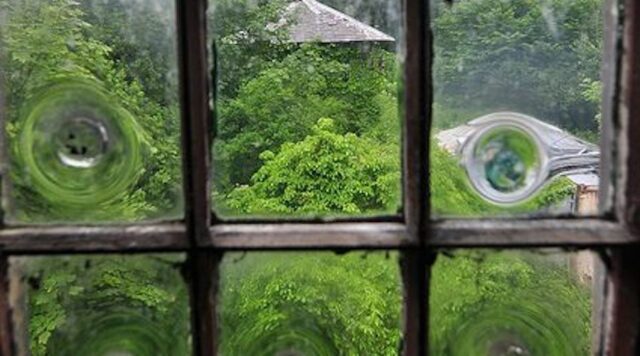
As the 19th century wore on, cylinder glass became the norm. This is produced by making an iron cylinder as a mould, blowing glass into it, and then carefully un-rolling the cylinder while the glass is still viscous to form a reasonably-even and flat sheet. Compared to spun glass, this approach makes it possible to make larger window panes. Also: it scales more-easily to industrialisation, reducing the cost of glass.
The Dutch window tax survived into the era of large plate glass, and this lead to an interesting phenomenon: rather than have lots of windows, which would be expensive, late-19th century buildings were constructed with windows that were as large as possible to maximise the ratio of the amount of light they let in to the amount of tax for which they were liable6.
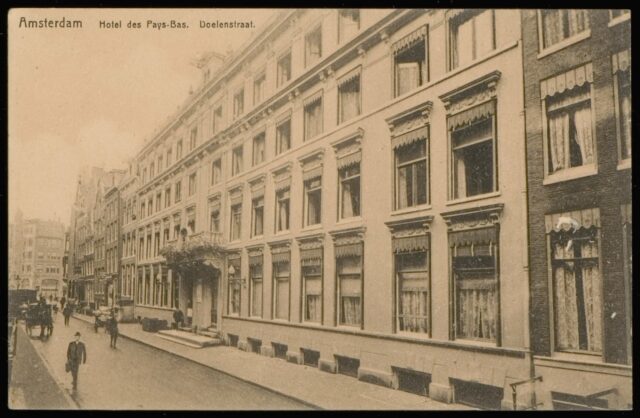
That’s an architectural trend you can still see in Amsterdam (and elsewhere in Holland) today. Even where buildings are renovated or newly-constructed, they tend – or are required by preservation orders – to mirror the buildings they neighbour, which influences architectural decisions.

It’s really interesting to see the different architectural choices produced in two different cities as a side-effect of fundamentally the same economic choice, resulting from slightly different starting conditions in each (a half-century gap and a land shortage in one). While Britain got fewer windows, the Netherlands got bigger windows, and you can still see the effects today.
…and social status
But there’s another interesting this about this relatively-recent window tax, and that’s about how people broadcast their social status.

In some of the traditionally-wealthiest parts of Amsterdam, you’ll find houses with more windows than you’d expect. In the photo above, notice:
- How the window density of the central white building is about twice that of the similar-width building on the left,
- That a mostly-decorative window has been installed above the front door, adorned with a decorative leaded glass pattern, and
- At the bottom of the building, below the front door (up the stairs), that a full set of windows has been provided even for the below-ground servants quarters!
When it was first constructed, this building may have been considered especially ostentatious. Its original owners deliberately requested that it be built in a way that would attract a higher tax bill than would generally have been considered necessary in the city, at the time. The house stood out as a status symbol, like shiny jewellery, fashionable clothes, or a classy car might today.

Can we bring back 19th-century Dutch social status telegraphing, please?9
Footnotes
1 Following the Treaty of Union the window tax was also applied in Scotland, but Scotland’s a whole other legal beast that I’m going to quietly ignore for now because it doesn’t really have any bearing on this story.
2 The second-hardest thing about retrospectively graphing the cost of window tax is finding a reliable source for the rates. I used an archived copy of a guru site about Wolverhampton history.
3 Even relatively-recently, the argument that income tax might be repealed as incompatible with British values shows up in political debate. Towards the end of the 19th century, Prime Ministers Disraeli and Gladstone could be relied upon to agree with one another on almost nothing, but both men spoke at length about their desire to abolish income tax, even setting out plans to phase it out… before having to cancel those plans when some financial emergency showed up. Turns out it’s hard to get rid of.
4 There are, of course, other potential reasons for bricked-up windows – even aesthetic ones – but a bit of a giveaway is if the bricking-up reduces the number of original windows to 6, 9, 14 or 19, which are thesholds at which the savings gained by bricking-up are the greatest.
5 You’ve probably heard about how glass remains partially-liquid forever and how this explains why old windows are often thicker at the bottom. You’ve probably also already had it explained to you that this is complete bullshit. I only mention it here to preempt any discussion in the comments.
6 This is even more-pronounced in cities like Amsterdam where a width/frontage tax forced buildings to be as tall and narrow and as close to their neighbours as possible, further limiting opportunities for access to natural light.
7 Yet I’m willing to learn a surprising amount about Dutch tax law of the 19th century. Go figure.
8 Obligatory Pet Shop Boys video link. Can that be a thing please?
9 But definitely not 17th-century Dutch social status telegraphing, please. That shit was bonkers.
Dan Q found GCAJGEA Welcome to Amsterdam! (Virtual Reward 4.0)
This checkin to GCAJGEA Welcome to Amsterdam! (Virtual Reward 4.0) reflects a geocaching.com log entry. See more of Dan's cache logs.
TFTC! I’m not carrying any tickets for UK transport, but I’ve got a (mildly defaced) British banknote and I found a tram (the number 13, which connected me to my hotel this week) and a ferry (which I then went and caught to go find some more caches!).
Dan Q found GC7RN72 #33 D.J.F. – Moana
This checkin to GC7RN72 #33 D.J.F. – Moana reflects a geocaching.com log entry. See more of Dan's cache logs.
Stared at its excellent camouflage for a while before realising what this was! Paddled down by inflatable canoe (picture attached) and landed right by here. Thought to check for local caches as we deflated the boats and was delighted that this one was right here in this picturesque spot! TFTC.
Dan Q found GCYK2M Got A Light Boy ? Longships Lighthouse
This checkin to GCYK2M Got A Light Boy ? Longships Lighthouse reflects a geocaching.com log entry. See more of Dan's cache logs.
I just launched my partner’s brother – shown in free attached picture – out in his rowboat to begin his attempt to row from Land’s End to John O’ Groats. Naturally this first involves rowing South, around the headland and past the lighthouse, to get to Land’s End! So I came up the hill to watch him get started. And while I was at it, I figured I’d find this cache! Took travel bug. TFTC!
The Last Supper
At the weekend, Ruth‘s brother Robin begins his attempt to row the length of the UK (by inland waterways where possible). I just received this invitation to see him off…
Narrowboating
I’ve had a tardy summer for blogging, falling way behind on many of the things I’d planned to write about. Perhaps the problem is that I’m still on Narrowboat Time, the timezone of a strange parallel universe in which everything happens more-slowly, in a gin-soaked, gently-rocking, slowly-crawling haze.

That’s believable, because this summer Ruth, JTA and I – joined for some of the journey by Matt – rented a narrowboat and spent a week drifting unhurriedly down the Monmouthshire and Brecon Canal… and then another week making a leisurely cruise back up it again.

We picked up Nerys, out of Cambrian Cruisers, who also gave us an introduction to the operation of the boat (driving it, filling it with water, pumping out sewage, generating electricity for appliances, etc.) and safety instructions (virtually all of the canal is less than four feet deep, so if you fall in, the best thing to do is to simply walk to the shore), and set out towards Brecon. In order to explore the entire canal in the time available, we needed to cover an average of only five miles per day. When you’re going at about two and a half miles per hour and having to stop to operate locks (there are only six locks on the navigable stretch of the canal, but they’re all clustered towards the upper end), though, five miles is plenty.

The upper end of the canal is by far the busiest, with not only narrowboats cruising up and down but a significant number of day boats (mostly on loan from Brecon) and at least one tour boat: a 50-seater that you don’t want to have to wiggle past at sharp corner North of the Bryich Aqueduct. From a navigation perspective, though, it’s also the best-maintained: wide enough that two boats can pass one another without much thought, and deep enough across its entire width that you needn’t be concerned about running aground, it makes for a great starting point for people who want some narrowboating practice before they hit the more challenging bits to the South.

Ruth was excited to find in me a driver who was confident holding the boat steady in a lock. Perhaps an expression of equal parts talent and arrogance, I was more than happy to take over the driving, leaving others to jump out and juggle the lock gates and lift bridges. Owing to Ruth’s delicate condition, we’d forbidden her from operating the entirely-manual locks, but she made sure to get a go at running one of the fancy hydraulic ones.

After each day’s cruising, we’d find a nice place to moor up, open a bottle of wine or mix up some gin-and-tonics, and lounge in the warm, late summer air.

As we wound our way further South, to the “other” end of the waterway, we discovered that the already-narrow canal was ill-dredged, and drifting anywhere close to the sides – especially on corners – was a recipe for running around. Crewmates who weren’t driving would take turns on “pole duty”, being on standby to push us off if we got too close to one or the other bank.

Each night moored up in a separate place gives a deceptive feeling of travel. Deceptive, because I’ve had hiking trips where I’ve traveled further each day than we did on our boat! But the nature of the canal, winding its way from the urban centre of Brecon out through the old mining villages of South Wales.

The canal, already quite narrow and shallow, only became harder to navigate as we got further South. Our weed hatch (that’s the door to the propeller box, that is, not a slang term for the secret compartment where you keep your drugs) saw plenty of use, and we found ourselves disentangling all manner of curious flora in order to keep our engine pushing us forwards (and not catching fire).

Eventually, we had to give up navigating the waterway, tie up, and finish the journey on foot. We could have gotten the boat all the way to the end, but it’d have been a stop-start day of pushing ourselves off the shallow banks and cleaning out the weed hatch. Walking the last few miles – with a stop either way at a wonderful little pub called The Open Hearth – let us get all the way to both ends of the navigable stretch of the canal, with a lot less hassle and grime.

It’s a little sad coming to the end of a waterway, cut short – in this case – by a road. There’s no easy way – short of the removal of an important road, or the challenging and expensive installation of a drop lock, that this waterway will ever be connected at this point again. The surrounding landscape doesn’t even make it look likely that it’ll be connected again by a different route, either: this canal is broken here.

I found myself remarking on quite how well-laid-out the inside of the narrowboat was. Naturally, on a vehicle/home that’s so long and thin, a great number of clever decisions had clearly been made. The main living space could be converted between a living room, dining room, and bedroom by re-arranging planks and poles; the kitchen made use of carefully-engineered cupboards to hold the crockery in place in case of a… bump; and little space-saving features added up all along the boat, such as the central bedroom’s wardrobe door being adaptable to function as a privacy door between the two main bedrooms.

On the way back up the canal, we watched the new boaters setting out in their narrowboats for the first time. We felt like pros, by now, gliding around the corners with ease and passing other vessels with narry a hint of a bump. We were a well-oiled machine, handling every lock with ease. Well: some ease. Unfortunately, we’d managed to lose not one but both of our windlasses on the way down the canal and had to buy a replacement pair on the way back up, which somewhat dented our “what pros we are” feeling.

Coming to the end of our narrowboating journey, we took a quick trip to Fourteen Locks, a beautiful and series of locks with a sophisticated basin network, disconnected from the remains of the South Wales canal network. They’ve got a particular lock (lock 11), there, whose unusual shape hints at a function that’s no-longer understood, which I think it quite fabulously wonderful – that we could as a nation built a machine just 200 years ago, used it for a hundred years, and now have no idea how it worked.

Our next stop was Ikea, where we’d only meant to buy a couple of shelves for our new home, but you know how it is when you go to Ikea.
We wrapped up our holiday with a visit to Sian and Andy (and their little one), and Andy showed off his talent of singing songs that send babies to sleep. I swear, if he makes an album of children’s songs and they’re as effective as he is in person, we’ll buy a copy.

Altogether, a wonderfully laid-back holiday that clearly knocked my sense of urgency so far off that I didn’t blog about it for several months.
Edit, 22 June 2018: after somebody from the Canal & River Trust noticed that my link to their page on the Brynich Aqueduct was broken after they’d rearranged their site, I removed it. They suggested an alternative page, but it didn’t really have the same content (about the aqueduct itself) so I’ve just removed the link. Boo, Canal & River Trust! Cool URIs Don’t Change!
TIL that ‘Hellburners’, 16th century fire-ships filled with decks of gunpowder sandwiched between bricks and tombstones, are considered to be an early WMD.
This link was originally posted to /r/todayilearned. See more things from Dan's Reddit account.
The original link was: https://en.wikipedia.org/wiki/Hellburners
Hellburners (Dutch: hellebranders) were specialised fireships used in the Siege of Antwerp (1584-1585) during the Eighty Years’ War between the Dutch rebels and the Habsburgs. They were floating bombs, also called “Antwerp Fire”, and did immense damage to the Spanish besiegers. Hellburners have been described as an early form of weapons of mass destruction.
Wikipedia
A Punting Story
This story actually relates to an event that happened in mid-2010, but I only recently got around to finishing writing about it.
Once upon a time there was a boy named Dan.
 Dan lives in a big house with his friends Ruth and JTA.
Dan lives in a big house with his friends Ruth and JTA.
 (their other friend, Paul, lives in
the house, too… but he isn’t in this story)
(their other friend, Paul, lives in
the house, too… but he isn’t in this story)
 One day, Dan and Ruth and JTA went on an adventure. They packed up a picnic with all their favourite foods.
One day, Dan and Ruth and JTA went on an adventure. They packed up a picnic with all their favourite foods.
 Big soft sandwiches, teeny-tiny sausages, cheese-with-holes-in, and a big box of chocolates. Then they got onto a bus.
Big soft sandwiches, teeny-tiny sausages, cheese-with-holes-in, and a big box of chocolates. Then they got onto a bus.
 Soon, they saw a big, wide river. “Let’s get off here,” said Ruth. JTA pressed the button to tell the bus driver to stop.
Soon, they saw a big, wide river. “Let’s get off here,” said Ruth. JTA pressed the button to tell the bus driver to stop.
 At the river, there was a man with all kinds of boats: boats with pedals, boats with paddles, and boats with poles.
At the river, there was a man with all kinds of boats: boats with pedals, boats with paddles, and boats with poles.
 “Can we borrow one of your boats?” Dan asked the man.
“Can we borrow one of your boats?” Dan asked the man.
“Okay,” he said, and gave Dan a long pole.
 Ruth and JTA got into the boat and sat down. Dan stood up on the very back of the boat. It was very wobbly!
Ruth and JTA got into the boat and sat down. Dan stood up on the very back of the boat. It was very wobbly!
Dan used the pole to reach all the way down the bottom of the river, and pushed the boat along. It was hard work!
They found a shady tree in a park, stopped the boat, and ate their picnic.
They drank some fizzy wine and felt all bubbly and dizzy. Soon it was time to get back on the boat and go back along the river.
One time, Dan almost fell into the water! But luckily he didn’t, and he, Ruth and JTA got back safely.
And they all lived happily ever after.

